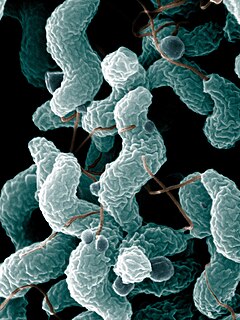Related Research Articles
The Thermomicrobia is a group of thermophilic green non-sulfur bacteria. Based on species Thermomicrobium roseum and Sphaerobacter thermophilus, this bacteria class has the following description:
In taxonomy, the Thermoplasmataceae are a family of the Thermoplasmatales. It contains only one genus, Thermoplasma. All species within Thermoplasmataceae are thermoacidophiles, and they grow at a temperature of 60°C and pH 2. They were isolated from hydrothermal vents, fumaroles and similar environments.

Haloarchaea are a class of the Euryarchaeota, found in water saturated or nearly saturated with salt. Halobacteria are now recognized as archaea, rather than bacteria and are one of the largest groups. The name 'halobacteria' was assigned to this group of organisms before the existence of the domain Archaea was realized, and while valid according to taxonomic rules, should be updated. Halophilic archaea are generally referred to as haloarchaea to distinguish them from halophilic bacteria.

Campylobacterota are a phylum of bacteria. All species of this phylum are Gram-negative.

The fauna of Puerto Rico is similar to other island archipelago faunas, with high endemism, and low, skewed taxonomic diversity. Bats are the only extant native terrestrial mammals in Puerto Rico. All other terrestrial mammals in the area were introduced by humans, and include species such as cats, goats, sheep, the small Indian mongoose, and escaped monkeys. Marine mammals include dolphins, manatees, and whales. Of the 349 bird species, about 120 breed in the archipelago, and 47.5% are accidental or rare.

In taxonomy, the Methanosarcinales are an order of the Methanomicrobia.
The Pyrodictiaceae are a family of disc-shaped anaerobic microorganisms belonging to the order Desulfurococcales, in the domain Archaea. Members of this family are distinguished from the other family (Desulfurococcaceae) in the order Desulfurococcales by having an optimal growth temperature above 100 °C, rather than below 100 °C.
In taxonomy, Roseivivax is a genus of the Rhodobacteraceae.
In taxonomy, Roseibacterium is a genus of the Rhodobacteraceae.
In taxonomy, Roseibium is a genus of the Hyphomicrobiales.
In taxonomy, Rubrimonas is a genus of the Rhodobacteraceae.
In taxonomy, Methanosalsum is a genus of microbes within the family Methanosarcinaceae. This genus contains two species.
In taxonomy, Methanotorris is a genus of the Methanocaldococcaceae. The organisms in this genus differ from those of Methanothermococcus in that they are hyperthermophiles and from those of Methanocaldococcus in that they have no flagella, are not motile, and do not require selenium to grow. These microbes have not been shown to cause any illnesses.
In taxonomy, Methanospirillum is a genus of microbes within the family Methanospirillaceae. All its species are methanogenic archaea. The cells are bar-shaped and form filaments. Most produce energy via the reduction of carbon dioxide with hydrogen, but some species can also use formate as a substrate. They are Gram-negative and move using archaella on the sides of the cells. They are strictly anaerobic, and they are found in wetland soil and anaerobic water treatment systems.
The Chloroflexota are a phylum of bacteria containing isolates with a diversity of phenotypes, including members that are aerobic thermophiles, which use oxygen and grow well in high temperatures; anoxygenic phototrophs, which use light for photosynthesis ; and anaerobic halorespirers, which uses halogenated organics as electron acceptors.
Deferribacter desulfuricans is a species of sulfur-, nitrate- and arsenate-reducing thermophile first isolated from a deep-sea hydrothermal vent. It is an anaerobic, heterotrophic thermophile with type strain SSM1T.
Penicillium jamesonlandense is a psychrotolerant species of the genus of Penicillium. Penicillium jamesonlandense produces patulin
Streptomyces abyssalis is a bacterium species from the genus Streptomyces which has been isolated from deep sea sediments in the South China Sea on the Xisha Islands in China.
Thalassotalea loyana is a bacterium from the genus of Thalassotalea. Thalassomonas loyana can cause white plague disease in the coral Favia favus.
Lebetimonas is a genus of bacteria from the family Nautiliaceae.
References
- 1 2 3 "Profundimonas". www.uniprot.org.
- 1 2 Margesin, Rosa (2017). Psychrophiles: From Biodiversity to Biotechnology. Springer. ISBN 9783319570570.
- ↑ Cao, Y; Chastain, RA; Eloe, EA; Nogi, Y; Kato, C; Bartlett, DH (January 2014). "Novel psychropiezophilic Oceanospirillales species Profundimonas piezophila gen. nov., sp. nov., isolated from the deep-sea environment of the Puerto Rico trench". Applied and Environmental Microbiology. 80 (1): 54–60. doi:10.1128/AEM.02288-13. PMC 3911031 . PMID 24123740.
- ↑ Stal, Lucas J.; Cretoiu, Mariana Silvia (2016). The Marine Microbiome: An Untapped Source of Biodiversity and Biotechnological Potential. Springer. ISBN 9783319330006.